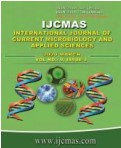


 National Academy of Agricultural Sciences (NAAS)
National Academy of Agricultural Sciences (NAAS)

|
PRINT ISSN : 2319-7692
Online ISSN : 2319-7706 Issues : 12 per year Publisher : Excellent Publishers Email : editorijcmas@gmail.com / submit@ijcmas.com Editor-in-chief: Dr.M.Prakash Index Copernicus ICV 2018: 95.39 NAAS RATING 2020: 5.38 |
Nile Tilapia (Oreochromis niloticus) is an important aquaculture resource that represents one of the most popular cultured species in the whole world. However, culture of this species face some problems, which are associated with the occurrence of pathogenic bacteria and cause high pecuniary loss. The main aim of this study was to isolate and identify the pathogenic bacteria from diseased farmed O. niloticus and to detect the antibiotic sensitivity with some commonly used antibiotics. Bacteria samples were collected from different parts of the body of both diseased and fresh tilapia and cultured in both nutrient agar and broth media. The bacterial colonies were evaluated using biochemical tests i.e. Gram’s staining, Motility test, Carbohydrate fermentation test, Indole test, MR-VP test and Catalase test. The antibiotic sensitivity of the isolated bacteria samples was also detected, using seven antibiotic discs i.e. Ciprofloxacin (5μg), Azithromycin (15μg), Ampicillin (10μg), Tetracycline (30μg), Streptomycin (30μg), Ceftriaxone (30μg) and Erythromycin (15μg). Colony characters and the biochemical analysis revealed the presence of Streptococcus agalactiae, Flavobacterium columnare and Edwardsiella tarda in farmed diseased tilapia, and Aeromonas salmonicida and Streptococcus iniae in healthy tilapia. Based on the density of colonies and clinical signs, the studied tilapia were infected by S. agalactiae, causing Streptococcosis. Co-infections in tilapia were occurred by F. columnare and E. tarda. Among the antibiotics, tetracycline and ciprofloxacin were more sensitive, azithromycin and streptomycin were moderately sensitive, and ampicillin was resistant to the isolated bacteria. Ciprofloxacin and tetracycline could be used to control the disease in the studied tilapia. The results of the study will be helpful to the farmers for management of bacterial diseases.
 |
 |
 |
 |
 |